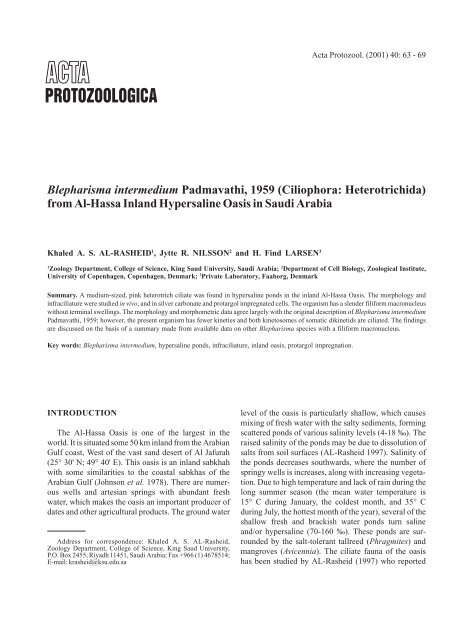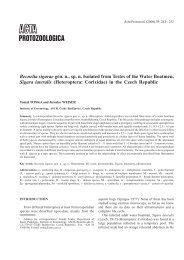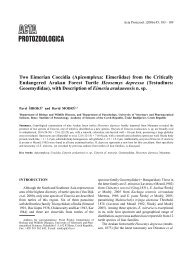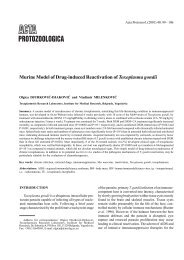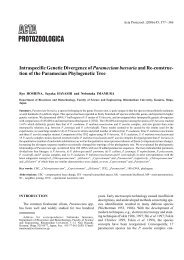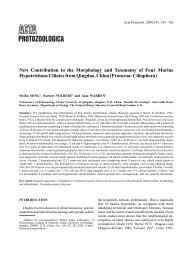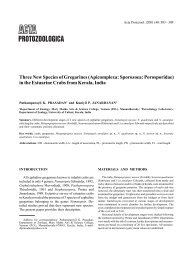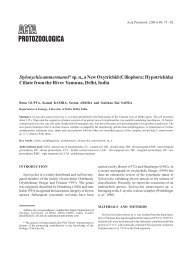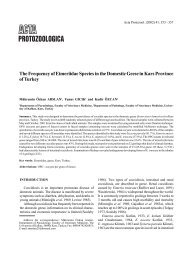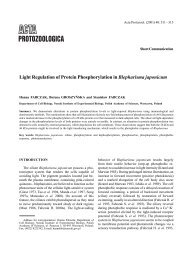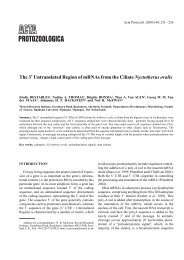Blepharisma intermedium Padmavathi, 1959 (Ciliophora ...
Blepharisma intermedium Padmavathi, 1959 (Ciliophora ...
Blepharisma intermedium Padmavathi, 1959 (Ciliophora ...
You also want an ePaper? Increase the reach of your titles
YUMPU automatically turns print PDFs into web optimized ePapers that Google loves.
Acta Protozool. (2001) 40: 63 - 69<br />
<strong>Blepharisma</strong> <strong>intermedium</strong> <strong>Padmavathi</strong>, <strong>1959</strong> (<strong>Ciliophora</strong>: Heterotrichida)<br />
from Al-Hassa Inland Hypersaline Oasis in Saudi Arabia<br />
Khaled A. S. AL-RASHEID 1 , Jytte R. NILSSON 2 and H. Find LARSEN 3<br />
1<br />
Zoology Department, College of Science, King Saud University, Saudi Arabia; 2 Department of Cell Biology, Zoological Institute,<br />
University of Copenhagen, Copenhagen, Denmark; 3 Private Laboratory, Faaborg, Denmark<br />
Summary. A medium-sized, pink heterotrich ciliate was found in hypersaline ponds in the inland Al-Hassa Oasis. The morphology and<br />
infraciliature were studied in vivo, and in silver carbonate and protargol impregnated cells. The organism has a slender filiform macronucleus<br />
without terminal swellings. The morphology and morphometric data agree largely with the original description of <strong>Blepharisma</strong> <strong>intermedium</strong><br />
<strong>Padmavathi</strong>, <strong>1959</strong>; however, the present organism has fewer kineties and both kinetosomes of somatic dikinetids are ciliated. The findings<br />
are discussed on the basis of a summary made from available data on other <strong>Blepharisma</strong> species with a filiform macronucleus.<br />
Key words: <strong>Blepharisma</strong> <strong>intermedium</strong>, hypersaline ponds, infraciliature, inland oasis, protargol impregnation.<br />
INTRODUCTION<br />
The Al-Hassa Oasis is one of the largest in the<br />
world. It is situated some 50 km inland from the Arabian<br />
Gulf coast, West of the vast sand desert of Al Jafurah<br />
(25° 30' N; 49° 40' E). This oasis is an inland sabkhah<br />
with some similarities to the coastal sabkhas of the<br />
Arabian Gulf (Johnson et al. 1978). There are numerous<br />
wells and artesian springs with abundant fresh<br />
water, which makes the oasis an important producer of<br />
dates and other agricultural products. The ground water<br />
Address for correspondence: Khaled A. S. AL-Rasheid,<br />
Zoology Department, College of Science, King Saud University,<br />
P.O. Box 2455, Riyadh 11451, Saudi Arabia; Fax +966 (1) 4678514;<br />
E-mail: krasheid@ksu.edu.sa<br />
level of the oasis is particularly shallow, which causes<br />
mixing of fresh water with the salty sediments, forming<br />
scattered ponds of various salinity levels (4-18 ‰). The<br />
raised salinity of the ponds may be due to dissolution of<br />
salts from soil surfaces (AL-Rasheid 1997). Salinity of<br />
the ponds decreases southwards, where the number of<br />
springy wells is increases, along with increasing vegetation.<br />
Due to high temperature and lack of rain during the<br />
long summer season (the mean water temperature is<br />
15° C during January, the coldest month, and 35° C<br />
during July, the hottest month of the year), several of the<br />
shallow fresh and brackish water ponds turn saline<br />
and/or hypersaline (70-160 ‰). These ponds are surrounded<br />
by the salt-tolerant tallreed (Phragmites) and<br />
mangroves (Avicennia). The ciliate fauna of the oasis<br />
has been studied by AL-Rasheid (1997) who reported
64 K. A. S. AL-Rasheid et al.<br />
37 species of typical marine ciliates including the two<br />
well known saline-tolerant species, Fabrea salina and<br />
Condylostoma reichi.<br />
A medium-sized, pink <strong>Blepharisma</strong> sp. with filiform<br />
macronuclei has been found in hypersaline ponds in the<br />
Saudi Arabian inland oasis Al-Hassa. Members of the<br />
genus <strong>Blepharisma</strong> are widespread and have been<br />
reported from fresh, brackish and sea water as well as<br />
from soils of many parts of the world (see for example<br />
Borror 1963; Isquith et al. 1965; Kattar 1965; Nilsson<br />
1967; Dragesco 1970; Larsen 1982, 1983, 1992; Larsen<br />
and Nilsson 1983, 1988; Dragesco and Dragesco-Kernéis<br />
1986, 1991; Foissner 1989; Foissner and O’Donoghue<br />
1990; Aescht and Foissner 1998; AL-Rasheid 1999).<br />
A few species have been found in extreme hypersaline<br />
habitats, such as B. halophila (Ruinen 1938, Post et al.<br />
1983), B. dileptus and B. tardum (Kahl 1928) and<br />
<strong>Blepharisma</strong> sp. (Wilbert 1995). The taxonomy of the<br />
genus <strong>Blepharisma</strong> has undergone several taxonomical<br />
revisions starting with Kahl (1932) then Bhandary (1962),<br />
Hirshfield et al. (1965, 1973) and finally Repak et al.<br />
(1977).<br />
The aim of the present work is to describe a population<br />
believed to be of <strong>Blepharisma</strong> <strong>intermedium</strong> found<br />
in Saudi Arabia and to give some information regarding<br />
the taxonomy of blepharismas with filiform macronuclei.<br />
MATERIALS AND METHODS<br />
The organism was found in hypersaline ponds (100-160 ‰<br />
salinity) North of the Oasis on several occasions during the summer<br />
and winter seasons of 1999 and 2000. Freshly collected sediment and<br />
water samples were studied on site. Several specimens of the ciliate<br />
organisms were collected, studied in vivo then in protargol and silver<br />
carbonate-stained preparations (Foissner 1991). Several short and<br />
long-term cultivation methods were conducted, but with no success<br />
as the cultures declined and died out rapidly. Specimen preparations<br />
of protargol and silver carbonate impregnated cells have been deposited<br />
in the Museum of Zoology Department, College of Science, King<br />
Saud University, Riyadh, Saudi Arabia.<br />
OBSERVATIONS<br />
The Saudi Arabian organism is slender, rounded anteriorly<br />
and posteriorly, and has a size of 239-359 x<br />
39-52 µm (in vivo ca 250 - 400 x 44 - 60 µm) (Figs. 1,<br />
11; Table 1). The pellicle is flexible with numerous dark<br />
pink subpellicular granules (0.4-0.5 µm in diameter)<br />
arranged in rows of approximately 8-12 granules across<br />
between the ciliary rows of kineties (Figs. 4, 5, 13, 14).<br />
Food vacuoles may be abundant, filled with bacteria,<br />
algae and diatoms (Figs. 11, 12). The contractile vacuole<br />
is found terminally (Fig. 1). The oral groove is long and<br />
narrow starting slightly below the anterior pole and<br />
stretching posteriorly to about the middle of the body<br />
(Figs. 2, 17). The entire left side of the groove is<br />
furnished with an adoral zone of membranelles (Fig. 15)<br />
in which each membranelle base consists of rows of<br />
basal bodies, two long and one short (Fig. 6). The right<br />
side is occupied by a paroral membrane, which ends<br />
posteriorly at the cytostome. The anterior third of the<br />
paroral membrane consists of a line of closely spaced<br />
basal bodies, while the remaining part consists of zigzagging<br />
dikinetids having only the right basal body ciliated<br />
(Fig. 15). Single long fibers (nematodesmata) originate<br />
from the left basal bodies in the posterior third of the<br />
paroral membrane and extend over the buccal cavity and<br />
enter the cytopharynx as oral ribs (Fig. 7). There are 25<br />
(21-27) somatic kineties; on the right side of the organism<br />
the rows of cilia run parallel to the oral groove, while<br />
on the left side the rows run obliquely (Figs. 2, 3, 13, 14;<br />
Table 1). The kineties consist of paired basal bodies and<br />
both are ciliated (Fig. 8). The somatic cilia are about 6-<br />
9 µm long. The kineties stop short just before the<br />
posterior end leaving a bare cytopyge free of cilia and<br />
subpellicular granules (Fig. 10). The single filiform macronucleus<br />
is without terminal swellings (Figs. 1, 3) and<br />
occurs in many twisted configurations (Fig. 9). The 5-9<br />
spherical micronuclei, each about 2 µm in diameter, are<br />
located close to the macronucleus (Figs. 3, 16; Table 1).<br />
Cultivation was unsuccessful, so it was not possible to<br />
study cell division, yet a few early and late postdividers<br />
were found naturally in several samples collected on<br />
different occasions. Examples are recorded in Figs. 18,<br />
19 for future studies.<br />
DISCUSSION<br />
In order to identify the present Saudi Arabian<br />
blepharisma taxonomically, a summary (Table 2) was<br />
made of the available data from the literature on<br />
<strong>Blepharisma</strong> spp. with filiform macronuclei. The present<br />
Arabian organism matches in some aspects <strong>Blepharisma</strong><br />
<strong>intermedium</strong> <strong>Padmavathi</strong> (<strong>1959</strong>), e.g. in the general size<br />
of the organism, in shape of the filiform macronucleus,<br />
and in some other morphometric features (see Table 2).<br />
However, the number of somatic kineties is lower<br />
(21-27) in the Arabian blepharisma than the 42-64
<strong>Blepharisma</strong> <strong>intermedium</strong> of Saudi Arabia 65<br />
Figs. 1-10. <strong>Blepharisma</strong> <strong>intermedium</strong> from life (1), after protargol impregnation (2, 3, 6-10) and after silver carbonate impregnation (4, 5).<br />
1 - right lateral view of a compressed organism showing the general appearance, many food vacuoles and the terminal contractile vacuole;<br />
2, 3 - infraciliature of right and left sides showing adoral zone of membranelles, paroral membrane, macronucleus and micronuclei; 4, 5 - details<br />
of pellicle with subpellicular cortical granules of right and left sides; 6 - detail of kinetosome arranged in adoral membranelle; 7 - detail of paroral<br />
membrane; 8 - detail of somatic infraciliature showing that both kinetosomes in a pair are ciliated; 9 - macronucleus variations; 10 - somatic<br />
infraciliature of the posterior end showing that the cytopyge opening is free of kinetosomes. AKF - anterior kinety fragment, AZM - adoral<br />
zone of membranelle, C - cilia, CV - contractile vacuole, CYP - cytopyge, FV - food vacuole, Ma - macronucleus, Mi - micronucleus,<br />
N - nematodesma, PM - paroral membrane, PKS - shortened postoral kinety. Scale bars - 75 µm (Figs. 1-3, 9), 15 µm (Figs. 4, 5, 7, 8, 10) and<br />
5 µm (Fig. 6)
Table 1. Morphometric characteristics of <strong>Blepharisma</strong> <strong>intermedium</strong> (Data based on randomly selected protargol-impregnated specimens). Measurements are in µm<br />
Character x M SD SE CV Min Max n<br />
Body, length 306.3 314 43.1 3.6 14.1 239 359 10<br />
Body, maximum width 44.8 45 4.3 1.4 9.6 39 52 10<br />
Adoral zone of membranelles, length 144 151 16.8 5.3 11.7 119 171 10<br />
Adoral zone of membranelles, width 5.0 5.1 0.2 0.1 4.0 4.5 5.2 20<br />
Adoral membranelles, number 86.4 87.5 6.8 2.2 7.9 76 98 10<br />
Paroral membrane, length 71.2 73.5 10.9 3.4 15.5 54 83 10<br />
Macronucleus, length 131 130 12.9 4.1 9.8 114 156 10<br />
Macronucleus, diameter 3.8 3.9 0.2 0.1 5.3 3.2 4.1 30<br />
Micronuclei, diameter 2.3 2.3 0.3 0.1 13.0 1.8 2.7 30<br />
Micronuclei, number 7.1 7.0 1.3 0.2 18.3 5 9 10<br />
Somatic kineties, number postoral 25 26 1.8 0.6 7.2 21 27 10<br />
66 K. A. S. AL-Rasheid et al.<br />
CV - coefficient of variation in %, M - median, Max - maximum, Min - minimum, n - number of individuals investigated, SD - standard deviation, SE - standard error of the mean,<br />
x- arithmetic mean<br />
Table 2. Comparison of some reported characteristics of <strong>Blepharisma</strong> with filiform macronucleus<br />
Species B. japonicum B. japonicum B. japonicum B. japonicum B. stoltei B. briviliformis B. <strong>intermedium</strong> B. <strong>intermedium</strong><br />
Author Suzuki 1954 Nilsson 1967 Dragesco 1970 Dragesco & Isquith Isquith <strong>Padmavathi</strong> present study<br />
Dragesco- 1966** 1966** <strong>1959</strong><br />
Kernéis 1986<br />
Locality Japan Uganda Cameroon Uganda Japan Japan India Saudi Arabia<br />
Length µm 150-500 250-700 400-650 225-400 145-225 120-195 200-350 239-359<br />
Width µm 62-215 90-260* 100-200 80-150 45-85 35-90 45-100 39-52<br />
Peristome length µm 75-250 75-350 150-230 100-185 70-125 50-85 70-140 119-171<br />
Somatic kineties number 50-70 60-100 54 76 50 36-54 42-64 21-27<br />
AZM number 91 90-178* 80 112 72 42-57 82 76-98<br />
PM length µm 30-50 50-230 50-110 25-50 24-60 15-35 25-50 54-83<br />
PM type prominent prominent prominent prominent not not not not<br />
prominent prominent prominent prominent<br />
Terminal swelling conspicuous conspicuous inconspicuous conspicuous conspicuous inconspicuous inconspicuous inconspicuous<br />
of macronucleus<br />
Micronuclei diameter 1.2 1 1.8-2.8 2 1.5-2 ? 1.97 1.8-2.7<br />
Micronuclei number 2-22 15-25 13-26 15-25 4-18 2-7 6-30 5-9<br />
Subpellicular granules deep red deep red red reddish pale pink ? dark pink dark pink<br />
color<br />
Subpellicular granules 6-10 5-8 ? ? 3-6 ? ? 8-12<br />
number<br />
* unpublished data, ** see Hirshfield et al. (1973)
<strong>Blepharisma</strong> <strong>intermedium</strong> of Saudi Arabia 67<br />
Figs. 11-17. Light micrographs of <strong>Blepharisma</strong> <strong>intermedium</strong> from life (11), after protargol impregnation (12, 15-17) and after silver carbonate<br />
impregnation (13, 14). 11 - right lateral view of a slightly compressed organism showing the general appearance; 12 - left lateral view showing<br />
the macronucleus, somatic kineties and a food vacuole containing a diatom (D); 13, 14 - right lateral views at different focus showing the<br />
arrangements of the longitudinal and oblique subpellicular granules of the right and left sides (the cells are swollen due to the silver carbonate<br />
technique); 15 - part of Fig. 12 at higher magnification showing the adoral zone of membranelles, macronucleus, the zigzagging part of the<br />
paroral membrane and the oral ribs. Arrowheads indicating that both paired kinetosomes of the dikinetids are ciliated; 16 - the filiform<br />
macronucleus with inconspicuous terminal swelling and the micronuclei. Arrowheads indicating that both paired kinetosomes of the dikinetids<br />
are ciliated; 17 - ventral view showing the anterior kinety fragment and other parts of the peristome. AZM - adoral zone of membranelles,<br />
CV - contractile vacuole, CYP - cytopyge, CYT - cytostome, D - diatom, FV - food vacuole, G - subpellicular granules, Ma - macronucleus,<br />
Mi - micronucleus, OR - oral ribs, P - peristome, PM - paroral membrane. Scale bars - 75 µm (Figs. 11 - 14), 25 µm (Figs. 15, 16) and 50 µm<br />
(Fig. 17)
68 K. A. S. AL-Rasheid et al.<br />
does not have a filiform macronucleus but about 60 small<br />
irregular, spheroid macronuclei which rules out any close<br />
relationship to the present Arabian organism.<br />
The colour of the ciliate is not an accurate taxonomical<br />
feature, as it is well known that the <strong>Blepharisma</strong><br />
pigment bleaches on exposure to light. The dark pink<br />
colour of the present organism may be explained by the<br />
heavy vegetation shading the saline ponds where it was<br />
found.<br />
In spite the fact that the somatic pairs of kinetosomes<br />
are both ciliated, an unusual feature, we conclude that<br />
the present organism with its filiform macronucleus is<br />
an Arabian strain of the freshwater <strong>Blepharisma</strong><br />
<strong>intermedium</strong> <strong>Padmavathi</strong> (<strong>1959</strong>).<br />
Acknowledgments. We wish to thank Dr. Irwin R. Isquith, School of<br />
Natural Sciences, Farleigh Dickinson University (USA) for his<br />
comments on the taxonomy of the organism.<br />
REFERENCES<br />
Figs. 18-19. Light micrographs of <strong>Blepharisma</strong> <strong>intermedium</strong> after<br />
protargol impregnation. Early (18) and late (19) postdividers.<br />
Cytostome positions are marked by asterisks. Ma - macronucleus,<br />
Mi - micronucleus. Scale bars - 25 µm<br />
kineties reported originally by <strong>Padmavathi</strong> (<strong>1959</strong>) for<br />
B. <strong>intermedium</strong>. In revisions of the genus <strong>Blepharisma</strong><br />
(Bhandary 1962; Hirshfield et al. 1965, 1973), the<br />
number of somatic kineties in B. <strong>intermedium</strong> is not<br />
mentioned. An unusual low number of 25-35 kineties<br />
was also found by Sawyer (1977) in B. japonicum<br />
Suzuki, so this feature may be unimportant (see Table 2).<br />
A striking feature of the Arabian ciliate is, however,<br />
that both kinetosomes of the somatic pairs are ciliated.<br />
This is an unusual feature in <strong>Blepharisma</strong> where most<br />
descriptions on the different species state that only one<br />
kinetosome of the somatic pairs is ciliated. To the best of<br />
our knowledge, the only other blepharisma reported to<br />
have both kinetosomes of somatic pairs ciliated, is<br />
B. parasalinarium (Dragesco 1996). This organism<br />
Aescht E., Foissner W. (1998) Divisional morphogenesis in<br />
<strong>Blepharisma</strong> americanum, B. undulans, and B. hyalinum (<strong>Ciliophora</strong>:<br />
Heterotrichida). Acta Protozool. 37: 71-92<br />
AL-Rasheid K. A. S. (1997) Records of free-living ciliates in Saudi<br />
Arabia. II. Freshwater benthic ciliates of Al-Hassa Oasis, Eastern<br />
Region. Arab Gulf J. Scient. Res. 15: 187-205<br />
AL-Rasheid K. A. S. (1999) Records of marine interstitial Heterotrichida<br />
(Ciliata) from the Saudi Arabian Jubail Marine Wildlife Sanctuary<br />
in the Arabian Gulf. Arab Gulf J. Scient. Res. 17: 127-141<br />
Bhandary A. V. (1962) Taxonomy of the genus <strong>Blepharisma</strong> with<br />
special reference to <strong>Blepharisma</strong> undulans. J. Protozool. 9: 435-<br />
442<br />
Borror A. C. (1963) Morphology and ecology of the benthic ciliated<br />
protozoa of Alligator Harbor. Arch. Protistenkd. 106: 465-534<br />
Dragesco J. (1970) Ciliés libres de Cameroun. Ann Fac Sci Yaoundé<br />
(Numéro hors-série)<br />
Dragesco J. (1996) Infraciliature et morphométire de cinq espèces de<br />
ciliés mésopsammiques méditerranéens. Cah. Biol. Mar. 37: 261-<br />
293<br />
Dragesco J., Dragesco-Kernéis A. (1986) Ciliés libres de l’ Afrique<br />
intertropicale. Fauna Tropicale 26: 1-559<br />
Dragesco J., Dragesco-Kernéis A. (1991) Free-living ciliates from the<br />
coastal area of Lake Tanganyika (Africa). Europ. J. Protistol. 26:<br />
216-235<br />
Foissner W. (1989) Morphologie und Infraciliature einiger neuer und<br />
wenig bekannter terrestrischer und limnischer Ciliaten (Protozoa,<br />
<strong>Ciliophora</strong>). Sber. Akad. Wiss. Wien. 196: 173-247<br />
Foissner W. (1991) Basic light and scanning electron microscopic<br />
methods for taxonomic studies of ciliated protozoa. Europ.<br />
J. Protistol. 27: 313-330<br />
Foissner W., O’Donoghue P. J. (1990) Morphology and infraciliature<br />
of some freshwater ciliates (Protozoa: <strong>Ciliophora</strong>) from western<br />
and south Australia. Invertebr. Taxon. 3: 661-696<br />
Hirshfield H. I., Isquith I. R., Bhandary A. V. (1965) A proposed<br />
organization of the genus <strong>Blepharisma</strong> Perty and description of<br />
four new species. J. Protozool. 12: 136-144<br />
Hirshfield H. I., Isquith I. R., DiLorenzo A. C. (1973) Classification,<br />
distribution and evolution. In: <strong>Blepharisma</strong>. The Biology of a<br />
Light Sensitive Protozoan, (Ed. A. C. Giese). Stanford University<br />
Press, Stanford, California 304-332
<strong>Blepharisma</strong> <strong>intermedium</strong> of Saudi Arabia 69<br />
Isquith I. R., Repak A. J., Hirshfield H. I. (1965) <strong>Blepharisma</strong> Nilsson J. R. (1967) An African strain of <strong>Blepharisma</strong> japonicum<br />
seculum, sp. nov., a member of the subgenus (Compactum). (Suzuki): a study of the morphology, giantism and cannibalism,<br />
J. Protozool. 12: 615-618<br />
and macronuclear aberration. Compt. Rend. Trav. Lab. Carlsberg<br />
Johnson D. H., Kamal M. R., Pierson G. O., Ramsay J. B. (1978) 36: 1-24<br />
Sabkas of Eastern Saudi Arabia. In: Quaternary Period in Saudi <strong>Padmavathi</strong> P. B. (<strong>1959</strong>) Studies on the cytology of an Indian species<br />
Arabia, (Eds. S. S. Al-Sayari and J. G. Zötl). Springer-Verlag, Wien of <strong>Blepharisma</strong> (Protozoa, Ciliata). Vìst. Èsl. Zool. Spol. 23:<br />
1: 84-93<br />
193-199<br />
Kahl A. (1928) Die Infusorien (Ciliata) der Oldesloer Salzwasserstellen. Post F. J., Borowitzka L. J., Borowitzka M. A., Mackay B., Moulton<br />
Arch. Protistenkd. 19: 50-123, 189-246<br />
T. (1983) The protozoa of a Western Australian hypersaline<br />
Kahl A. (1932) Urtiere oder Protozoa I: Wimpertiere oder Ciliata lagoon. Hydrobiologia 105: 95-113<br />
(Infusoria) 3. Spirotricha. Tierwelt Dtl. 25: 399-650<br />
Repak A. J., Isquith I. R., Nabel. M. (1977) A numerical taxonomic<br />
Kattar M. R. (1965) <strong>Blepharisma</strong> sinuosum Sawaya (Cilié, study of the heterotrich ciliate genus <strong>Blepharisma</strong>. Trans. Am.<br />
Hétérotriche). Bull. Soc. Zool. 90: 131-141<br />
Microsc. Soc. 96: 204-218<br />
Larsen H. F. (1982) Light microscopic observations and remarks on Ruinen J. (1938) Notizen über Ciliaten aus konzentrierten<br />
the ecology of <strong>Blepharisma</strong> persicinum Perty, 1849. Arch. Salzgewässern. Zool. Meded. 20: 243-256<br />
Protistenkd. 125: 63-72<br />
Sawyer H. R. (1977) Stomatic events accompanying binary fission<br />
Larsen H. F. (1983) Observations on the morphology and ecology of in <strong>Blepharisma</strong>. J. Protozool. 24:140-149<br />
<strong>Blepharisma</strong> lateritium (Ehrenberg, 1831) Kahl, 1932. Arch. Suzuki S. (1954) Taxonomic studies on <strong>Blepharisma</strong> undulans Stein<br />
Protistenkd. 127: 65-80<br />
with special reference to macronuclear variation. J. Sci. Hiroshima<br />
Larsen H. F. (1992) Süsswasserciliaten aus Grönland: <strong>Blepharisma</strong>, Univ. (ser. B. div. 1) 15: 205-220<br />
Tetrahymena und andere Arten. Mikrokosmos 81: 297-302 Wilbert N. (1995) Benthic ciliates of salt lakes. Acta Protozool. 34:<br />
Larsen H. F., Nilsson J. R. (1983) Is <strong>Blepharisma</strong> hyalinum truly 271-288<br />
unpigmented? J. Protozool. 30: 90-97<br />
Larsen H. F., Nilsson J. R. (1988) Observations on the ecology and<br />
morphology of <strong>Blepharisma</strong> elongatum (Stokes, 1884), Kahl,<br />
1926. Arch. Protistenkd. 136: 51-63 Received on 1st June, 2000; accepted on 5th September, 2000


